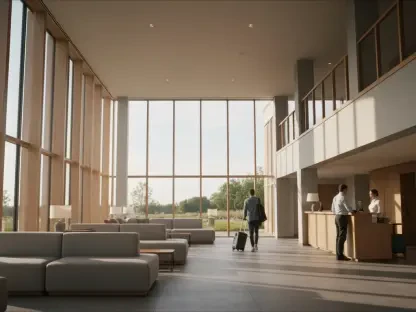In the bustling corridors of Capitol Hill, discussions about the Social Security Administration (SSA) reached a crucial juncture with the nomination of Frank Bisignano as its new leader. Former CEO of Fiserv, Bisignano is now under intense scrutiny as he takes the hot seat to confront the agency’s pressing issues under President Donald Trump’s administration. Will Bisignano’s promises to fix customer service lapses and protect data resonate with both Republican and Democratic senators?
The Confirmation Hearing Spotlight
Senate Concerns
During his confirmation hearing, Bisignano faced a barrage of questions from senators concerned about the SSA’s ongoing crisis. Staffing reductions, loopholes in customer service, and the disruptive changes brought about by the Trump administration and Elon Musk’s Department of Government Efficiency (DOGE) were at the forefront of discussions. Senators expressed their anticipation for Bisignano’s strategy to address these flaws within the agency as they anxiously awaited concrete plans.
Many senators were specifically alarmed over the drastic decline in workforce and field office closures. They feared the significant workforce reductions, amounting to 12%, would severely impact the SSA’s capacity to efficiently manage operations and deliver quality service across the nation. The closure of numerous field offices raised concerns over accessibility, primarily for the most vulnerable populations who depend on in-person services, intensifying the need for a comprehensive review of operations.
Addressing Workforce Reductions
The issue of workforce reductions took center stage as senators questioned how the agency could maintain its operations with such severe cuts. Bisignano acknowledged the concerns, explaining the necessity of strategic management and effective use of resources to minimize the negative impact on service delivery. He emphasized his intention to explore innovative approaches to streamline SSA’s operations without compromising the quality of service provided to the public.
However, skepticism from Democratic senators persisted. They warned that diminishing the workforce could lead to extensive backlog and long wait times, exacerbating the already troubling customer service issues. Bisignano responded by underscoring the importance of balancing resource management with technological advancements, which he believes could mitigate the repercussions of staff reductions.
The Role of DOGE
Data Security Concerns
A highlight of the confirmation hearing was the Senate’s focus on safeguarding the personal data managed by SSA and the contentious role of DOGE. Senators expressed apprehension about the Department of Government Efficiency, headed by Elon Musk, potentially gaining access to sensitive personal information. Bisignano faced rigorous inquiries regarding his plans to ensure data security amidst these sweeping changes.
Responding to these concerns, Bisignano reassured senators that he was committed to protecting individuals’ data. He acknowledged the federal court’s ruling that barred DOGE from accessing personal data files and vowed to strictly adhere to this mandate. His reassurances were aimed at calming the fears of data breaches and the potential misuse of sensitive information, which would undermine public trust in the SSA.
Promises of Technological Innovation
Bisignano presented a forward-thinking vision for the SSA, centered on leveraging technology and artificial intelligence to revitalize the agency’s services. He articulated his plans to implement technological innovations designed to cut telephone wait times to less than a minute and expedite the processing of disability claims. These advancements, he proposed, were pivotal to enhancing the overall efficiency and responsiveness of the SSA.
Notwithstanding the optimistic outlook, senators remained wary of the feasibility of these technological upgrades without an increase in staff. Bisignano argued that technology would significantly enhance operational efficiency, potentially reducing the need for a proportional staff increase. He emphasized the transformative potential of technology, which, if executed effectively, could fundamentally redefine the agency’s service delivery model.
The Political Divide
Skepticism Over Privatization
Amidst these discussions, the issue of potential privatization of SSA services loomed large. Democratic senators voiced their skepticism, questioning whether the Trump administration’s drastic changes to SSA were strategically paving the way for privatization. These concerns were met with strong denials from Bisignano, who firmly maintained that there was no agenda to privatize SSA’s services.
Bisignano reiterated Trump’s commitment to protecting Social Security, dismissing fears that privatization was on the horizon. He assured senators that the administration’s focus was on bolstering the inherent strengths of the SSA and ensuring that it continued to fulfill its mandate effectively.
Leadership and Accountability
Questions of leadership and accountability also figured prominently in the hearing. Bisignano addressed criticisms of the agency’s current state by attributing part of the turmoil to acting commissioner Leland Dudek’s collaboration with DOGE. He suggested that Dudek’s leadership had contributed to the disarray within the SSA, which was compounded by the introduction of controversial policies.
Despite his candid observations, critics were dissatisfied with Bisignano’s reluctance to explicitly disavow DOGE’s controversial influence. This hesitation stirred concerns among SSA advocates, who feared that the prevailing contentious policies would remain unaddressed. The emphasis was on the need for a clear stance against policies that could undermine the effectiveness of SSA operations.
Revamping SSThe Road Ahead
Balancing Reform and Continuity
Bisignano’s commitment to rapidly implementing reforms introduced the challenge of finding a balance between modernizing the SSA and maintaining the integrity of its services. The dialogue underscored the critical need for technological advancements to be coupled with strategic oversight and adequate staffing. Stakeholders emphasized that improvements should not disrupt the essential services rendered to millions of Americans.
To achieve this balance, Bisignano highlighted the necessity of a phased approach, ensuring that innovations were carefully integrated. Ensuring continuity of services while implementing technological reforms would be crucial for maintaining public trust and ensuring the SSA’s success in addressing current and future challenges without creating further disruptions.
The Stakes of Efficient Leadership
In the busy corridors of Capitol Hill, discussions about the Social Security Administration (SSA) have reached a critical point with the nomination of Frank Bisignano as its new head. Bisignano, formerly the CEO of Fiserv, is now under intense examination as he steps into the leadership role to address the agency’s urgent issues under President Donald Trump’s administration. The spotlight is on whether Bisignano’s vows to improve customer service and safeguard data will strike a chord with both Republican and Democratic senators. His leadership comes at a time when the SSA faces significant challenges, including delays in benefit processing and concerns over cybersecurity. With a background in financial services, Bisignano is believed to bring a fresh perspective, but he must navigate politically charged waters. Senators from both parties will be closely watching to see if he can deliver on his promises and steer the SSA toward better efficiency and security, ensuring it meets the needs of the American public.









